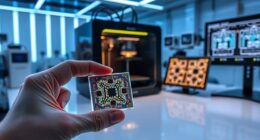Nano-robotic surgery uses tiny, smart devices to repair cells from inside your body. You can control these robots with external magnetic fields, guiding them through blood vessels and tissue. They perform precise, minimally invasive repairs, deliver treatments directly to affected areas, and monitor tissues in real time. This technology minimizes trauma, speeds healing, and improves outcomes. To discover how this revolutionary approach works and its future possibilities, keep exploring the advancements behind these microscopic surgeons.
Key Takeaways
- Nano-robots can navigate through blood vessels to access and repair damaged cells internally.
- They are equipped with sensors to detect tissue damage and target specific cellular areas.
- External magnetic fields enable precise control and maneuvering of nanorobots within the body.
- These devices can deliver drugs or perform cellular repairs directly at the molecular level.
- Nano-robotic surgery offers minimally invasive, targeted treatment, reducing recovery time and tissue trauma.

Nano-robotic surgery is revolutionizing medicine by enabling precise, minimally invasive procedures at the cellular level. Imagine tiny robots, no bigger than cells themselves, converting various energy sources into movement and force to perform delicate tasks inside your body. These micro and nanorobots are designed with dimensions compatible with cellular structures, allowing them to reach areas that traditional surgical tools simply can’t access. Their small size and advanced capabilities mean they can navigate narrow capillaries, deep tissue regions, and complex biological environments with remarkable accuracy.
Equipped with external magnetic fields, these devices can be dynamically controlled, guiding their orientation and movement in real time. This external control makes it possible to steer nanorobots precisely to the target site, whether it’s a clogged artery, tumor, or damaged nerve. Some nanorobots are untethered, such as nanodrillers, micro-grippers, and microbullets, each specialized for specific surgical tasks. For example, nanodrillers can perform microscopic drilling, micro-grippers can manipulate tissues or retrieve cellular debris, and microbullets can deliver targeted therapy. This versatility allows for high precision in procedures that traditionally required invasive methods.
The benefits of nanorobotic surgery extend beyond minimal invasiveness. Because these robots can directly penetrate or manipulate tissues at the cellular level, you experience less trauma, faster healing, and shorter recovery times. They can navigate through blood vessels or tissue regions inaccessible to larger instruments, enabling highly targeted interventions. This precision enhances treatment efficacy, especially for conditions like coronary artery disease, where intravascular therapy can be performed with minimal disturbance. Similarly, nanorobots can deliver drugs directly to tumor margins, improving outcomes in cancer treatments while reducing side effects.
Research is still in its early stages, but multidisciplinary teams worldwide are developing these tiny devices, focusing on making them smarter, more biocompatible, and capable of complex tasks. The future of nanorobotic surgery involves integrating sensors for real-time tissue detection, enhancing navigation techniques, and creating multifunctional devices that can perform several procedures simultaneously. Challenges remain, such as ensuring safe navigation, avoiding immune responses, and perfecting external control systems, but progress continues steadily.
In practice, nanorobots could be deployed through minimally invasive methods, circulating within your body to perform continuous monitoring or targeted interventions. Their ability to detect tissue margins, identify metastatic areas, and deliver localized treatment promises to transform many facets of medicine. Additionally, advancements in AI Security are critical to ensuring that these highly sophisticated devices remain safe from cyber threats and operate reliably within medical environments. Ultimately, nanorobotic surgery offers a future where cellular repair and disease treatment happen from within, with unprecedented precision, safety, and efficiency.
Frequently Asked Questions
How Long Does Nano-Robotic Surgery Recovery Typically Take?
You’re probably wondering how long recovery takes after minimally invasive surgeries. Typically, it’s quite short—most patients are discharged within about 5 days, and many procedures are same-day with no hospital stay. Recovery depends on factors like the targeted tissue, anesthesia used, and your overall health. With nano-robotic surgeries, expect less pain, quicker return to daily activities, and fewer complications, making your recovery faster and more comfortable.
What Are the Long-Term Risks of Nano-Robotic Cell Repair?
Imagine a knight’s armor slowly corroding over time—that’s how long-term risks of nanorobotic cell repair could unfold. You might face issues like chronic toxicity from material buildup, immune reactions, or unintended tissue damage. Control and clearance challenges could lead to lingering nanobots, possibly causing inflammation or cellular mutations. While promising, these long-term effects remain uncertain, requiring thorough research to guarantee safety and prevent hidden health hazards.
How Does Nano-Robotic Surgery Compare Cost-Wise to Traditional Methods?
You might wonder how advanced surgical methods compare financially to traditional ones. Currently, robotic surgeries cost more upfront due to expensive equipment, materials, and longer procedures, often increasing hospital bills. While they can reduce recovery time and complications, robust cost savings aren’t proven yet, especially for nano-robotic surgery. For now, traditional methods remain more affordable, but if nano-robotics become widespread, they may eventually offset initial costs with improved outcomes.
Can Nano-Robots Be Programmed to Target Specific Cell Types?
You ask if nano-robots can be programmed to target specific cell types. Yes, they can. You can functionalize their surfaces with ligands or antibodies that recognize unique receptors on target cells. Programmable DNA structures help them navigate and identify specific signals. External stimuli like magnetic or acoustic forces guide their movement, ensuring they reach precise locations. This combination of molecular recognition and external guidance enables highly accurate and selective targeting of desired cell populations.
Are There Ethical Concerns Surrounding Nano-Robotic Medical Treatments?
You should consider that ethical concerns with nano-robotic treatments involve accountability if harm occurs, especially with automation. You need to guarantee patient consent is fully informed despite complexity, and data privacy is protected. Equity matters too; treatments should be accessible to all, not just the wealthy. Balancing innovation with responsibility is vital, so you must stay aware of potential risks, transparency, and fairness to maintain trust and uphold moral standards.
Conclusion
As you consider this groundbreaking approach, remember that nano-robotic surgery offers a gentle touch to healing, working quietly within your cells. It’s like a delicate dance, softly guiding repair from the inside out, promising a future where health can be restored with subtlety and grace. While it’s still emerging, this technology hints at a new era—one where the tiniest helpers could make the biggest difference, quietly transforming medicine in ways you’d never have imagined.









